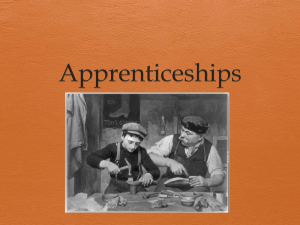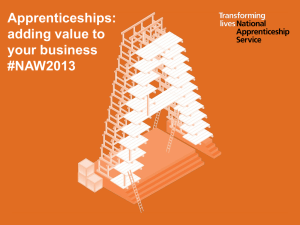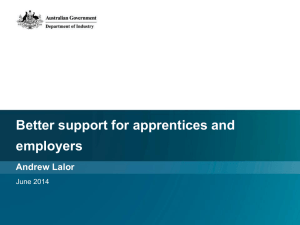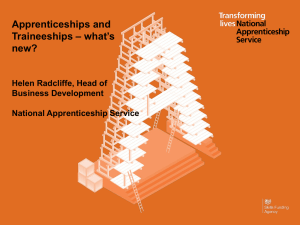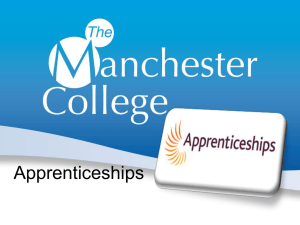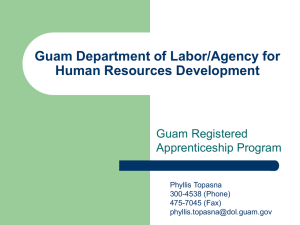Herzlich willkommen im Arbeitsmarktservice Österreich
advertisement
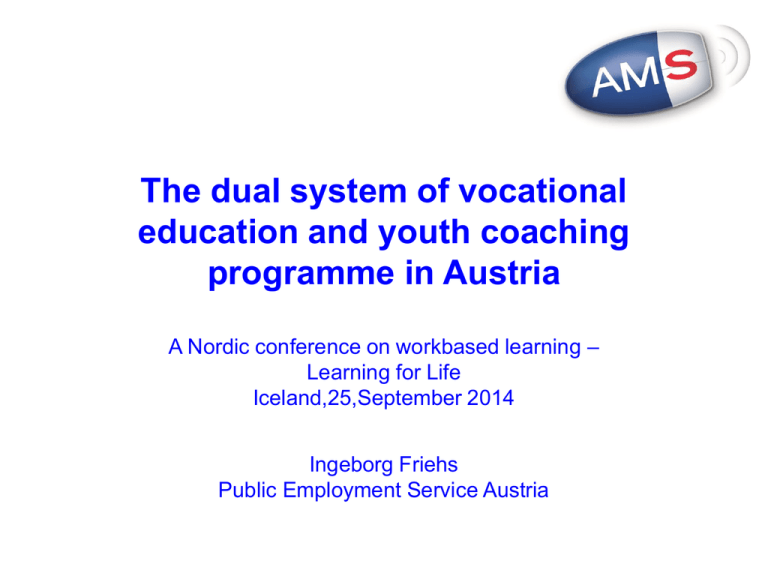
The dual system of vocational education and youth coaching programme in Austria A Nordic conference on workbased learning – Learning for Life Iceland,25,September 2014 Ingeborg Friehs Public Employment Service Austria The Austrian dual system What? Duration: 2-4 years Employment contract with the firm (special type – apprenticeship), remuneration 80% company- based learning, 20% school 200+ different professions with standardised curricula Final examination –diploma of completing a vocational education Possibility of passing an entry exam for university after completing the apprenticeship The Austrian dual system Who? 40% of each cohort, approx. 125.000 apprentices Usually after finishing compulsory school ( age 15) Offers opportunities also for weaker pupils Support for disadvantaged and those who couldn`t find an apprenticeship in a company : supra – company apprenticeship (training guarantee) and integrated vocational education (one year more than usual) The Austrian dual system How to find an apprenticeship position? Usually the young person applies directly at the company Support of the PES to find a company If no apprenticeship place can be found, young people can do a supra –company apprenticeship The Austrian dual system Why do firms offer apprenticeship positions? Long established system, widely recognised tradition to offer apprenticeship positions, (40.000 enterprises, each company needs a person who has a training authority) Investing in company-specific knowledge Preventing shortage of skilled workers The Austrian dual system Essential role of social partnership: For companies and employees it is obligatory to be a member of the Chamber of Commerce or the Chamber of labour respectively. Those two chambers are strongly committed to the apprenticeship system. They are strongly involved, in particular with regard to the deveopment of new trades or the adaption of the curricula.The overall orientation of the dual system has a strong focus on business needs. The Austrian dual system Financing : Enterprises develop voluntary at one`s own expense ( the whole training in the firm as well as the remuneration to the apprentices) Low remuneration – corresponding to the fact that apprentices are basically in a learning position but not in a full productive working position: Approx. 420€ in the first year, 540€ in the second,770€ in the third and 840€ in the fourth year( the remuneration is higher in the metal processing industry ). – Corresponds to 10-20% of a skilled workers salary in the first year and 20-50% in the third year of apprenticeship. Schools (equippment, teachers) are financed by State Supra- company apprenticeship training is completely financed by State The Austrian dual system Subsidies to employers: Yearly basic subsidy: It amounts to three times the apprentisceship compensation in the first year, two times in the second and once in the third and fourth year Additional quality related subsidies ( for every final examination with excellent grades, support for further education of trainers, measures for apprentices with learning deficits…) Special incentives for specific target groups ( women in maledominated occupations, disadvantaged ) , offered by PES or fundings for apprentices with disabilities, offered by the Federal Social Service The Austrian dual system Advantages from a labour market perspective: Training takes place under conditions of a real work life Always „state of the art“ – more flexibility to respond to technical progress in comparison to a school system. Labour market access is easier after completing the training (work practice available, training company knows the strengths and weaknesses of the individual young person) Better prospects for disadvantaged, late developed and weak young persons Training takes place predominately in productive work situation. This reduces costs and reinforces the learning motivation of the young people. The Austrian dual system Challenges: Change in the skills that are demanded. Focus is changing to more adapability and skills that are easier to inpart in schools. Frequently enterprises have to take over the role of the young people´s home regarding to learn a good behave. Trend towards a higher qualification and education, which allow directly entering into university with the consequence that predominantly weaker young people ore those who don`t want to go to school any more are candidates for apprenticeships.- Leads to a loss of image. Instability of jobs and apprenticeship positions is increasing and also the continuance in a company after completion has been decreasing. - Leads to uncertainty. In particular sectors (e.g.tourism), there is a shortage of apprentices while in sum more people are looking for an apprenticeship than positions are offered. Gender segregation and persons with migration background are underrepresented –a better vocational orientation becomes more important. The Austrian dual system Supracompany apprenticeship: Since 1998 offer of additional apprenticeship places (employment package), since 2008 training guarantee Target group. Those who couldn`t find an apprenticeship position or who did drop out of a company- based apprenticeship The priority is, to find an apprenticeship position within a company Two types: a.Supra –company apprenticeship training is carried out by an educational institution: • Theoretical training in a vocational school • Practical training offered by the educational institution • Training contract during the entire time of apprenticeship, (if necessary) between the educational institution and the apprentice • Goal: completion of apprenticeship (ideally in a firm) The Austrian dual system b. Cooperation between an educational institution and a private company: • Theoretical training in a vocational school • Practical training in a company • Training contract betwen the educational institution and the apprentice ( usually 1 year) Goal: transfer to apprenticeship in a company Participants receive comprehensive support: Socio-pedagogical counselling,learning support, assistence with job search or apprenticeship search The Austrian dual system Allowance for participants: € 270 per month in the first and second year, € 600 per month from the third year Places in supracompany apprenticeship training entities: around 12.000 Budget 2012/13: around 175Mio €, expenses per person and year: around 14.000€ Labour market integration within one year: more than 50% Youth Coaching Programme Target group: young people and people not in education, employment or training (NEETS) Goal: to keep young people within the education and training system as long as possible and Efforts are made to ensure that those who have already left the system will be offered the chance to resume their education or training. Youth Coaching has been created to ensure the interface of advice, guidance and support for young people from the end of compulsory school until such time as they are fully integrated into continuing training or educational programmes. Fields of support and advice are education and employment issues as well as personal issues Youth Coaching Programme Coaches offer free support and are responsible to cooperate and communicate with different programme partners (employment services, the federal social office, schools, municipalities, projects, training institutions, external counselling institutions) The pilot of this programme started in 2012 with about 12.500 participants and has been implemented in 2013 nationwide with around 35.000 persons. Result of the pilot-evaluation: Only 15% oft he participants dropped out or left the programme without a specific goal orientation, the programme turned out to be very successful. The programme is carried out by the Federal Social Office. Thank you for your attention!


